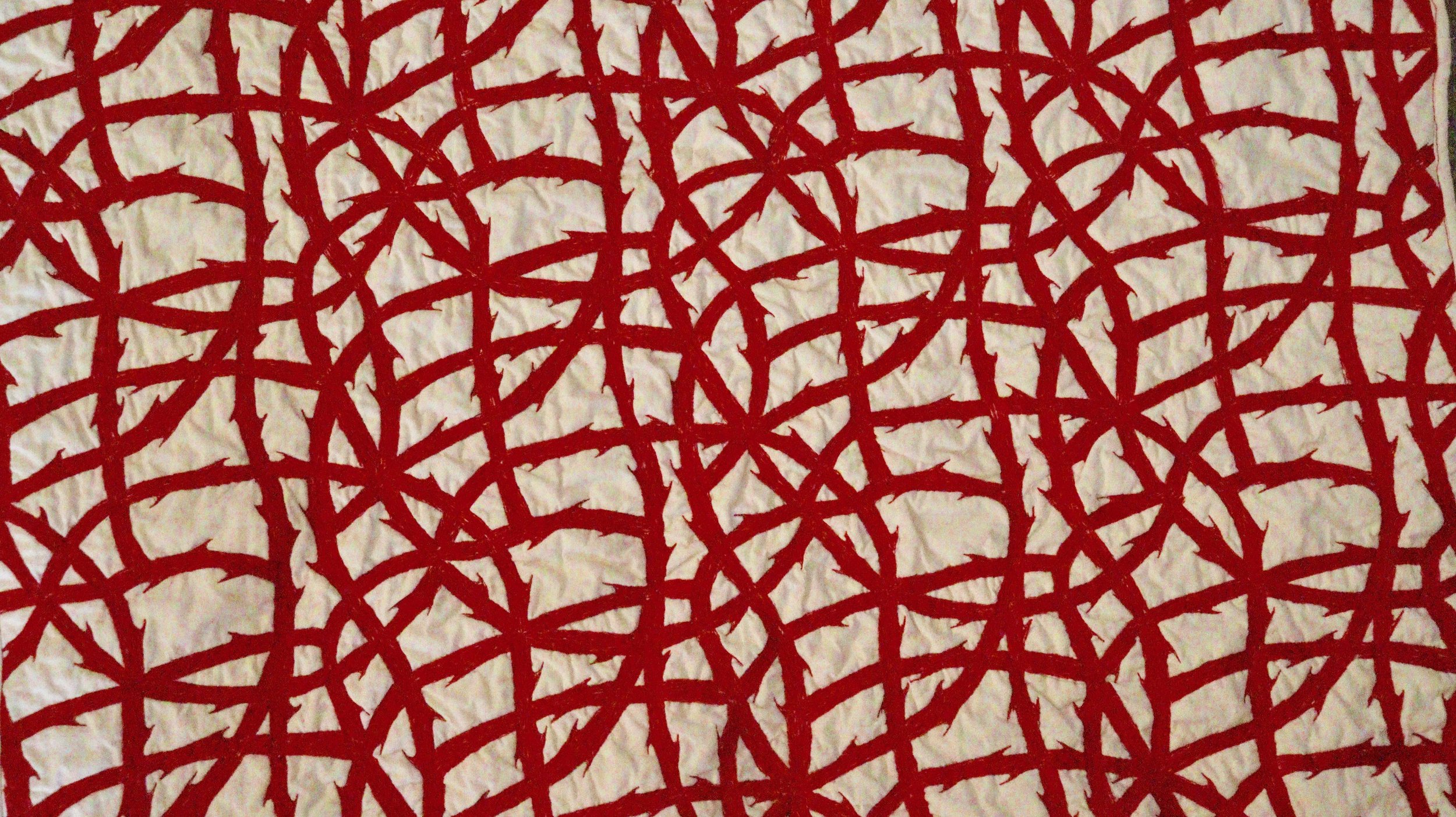Devils in the Darkness (2023)
Hand made quilts and appliqué
Created on Singer Heavy Duty Sewing Machine
100% cotton fibre, bamboo fibre
All work developed within the household
Presented at Seventh Gallery, Melbourne
In historic texts such as the Malleus Maleficarum feminine behaviour has been contextualised as evil and therefore a justification for punishment. This project looks into feminine behaviour and spaces, especially feminine rage and the home. These works aim to explore a sense of embracing these assumptions, to say if women are evil then so be it.
Juxtaposing the inherent comfort within textiles with concepts like witchcraft help to display the inherent tension within the female condition and lived experience. These works explore folk horror tropes and folk art designs to find a balance between visually pleasing and conceptually off-putting.
An exploration of the dynamics between femininity, domesticity and cruelty. Using folk horror and folk art references, this collection of textiles looks into aspects of evil observed within feminine behaviour and spaces.
An essay titled ‘Mirroring Malice’ was written by Teagan Ramsay to accompany this exhibition.
Images by Teagan Ramsay











Mirroring Malice
Words by Teagan Ramsay
Do you hear that? The screams of agony yowling over the town square, and the crackling of fire licking up at her bare legs. The phrase ‘witch hunt’ conjures a specific image, one of a woman tied to a stake and being burned alive. The figure of the witch morphs between an ironic dichotomy, one of a young and seductive feminine body and that of an old and decrepit hag. Young witches made pacts with the devil and beguiled men to lose their inhibitions, while the post-menopausal witch offered no financial or reproductive benefit to men who governed society. Witch hunting served as a religious vendetta against promiscuous sex and as a systematic campaign to suppress women's autonomy, knowledge, and resistance to capitalist exploitation.
The fear and repulsion of defiant women was perpetuated through the art and literature of the 15th century, namely the 1487 treatise Malleus Maleficarum. Produced by Dominican friars, Heinrich Kramer and Jacob Sprenger, the text sought to provide legal and theological justification for the witch trials while inciting mass hysteria and providing a framework for the persecution of thousands of individuals, who were accused of witchcraft [1]. The text’s insidious and misogynistic tone detailed women’s addiction to wickedness while condemning their greed, credulous nature, feeble mind and body, slippery tongue, jealous nature and their inherently evil disposition. This fallacy became embedded in early modern Europe with secular courts adopting the Malleus and labelling witches as heretics to Christianity.
The witch hunts were also deeply embedded in broader gender and class struggle, with the persecution of women being intricately linked to the exploitation of the working class. Women's bodies and reproductive labour became commodified and controlled to serve the interests of the emerging capitalist system. Birth control and abortion became criminalised, and any attempt to control women’s fertility was deemed a threat to the expansion of the labour force [2]. This exploitation diminished women's autonomy and solidarity, enabling the ruling elite to weaken resistance to their oppressive economic and social order. Through depictions of child offerings to the devil and self-performed abortions, the figure of the witch negated this supremacy becoming the personification of sexual and bodily independence.
Clara Martin humorously embraces the vilified figure of the witch through the embodied and ritualistic processes of textile practices. Martin weaves together the gendered associations of quilting–slow repetitive, ritualistic and meditative gestures– with folklore imagery and violent idioms. Sewn-in red gothic font, with red stitched seams, Martin’s phrase, I am made of carnal desire & hellish pleasure, embodies the erotic ecstasy and menacing resonance of a witch's most hedonistic traits. The text pairs with a white quilt adorned with an appliqué of interlocking thorned branches. Evocative of the Crown of Thorns, the thicket of circling branches hypnotise the viewer's optic, compelling you to locate a passage through the claustrophobic growth. Throughout Christian texts, the thorny branches of the plant signify the suffering Jesus endured during his crucifixion. Here, Martin presents us with text and imagery steeped in complex layers reminiscent of the witch archetype and Christian symbolism. Instead of unpicking these tropes, Martin leans into them deeply, articulating the interconnected and underlying narratives that have shaped the arms of patriarchal discourse–social production and religion.
Throughout history, quilts have been closely associated with feminised, socially reproductive labour, particularly due to their intimate connection with the bed as a place for procreative sex, childbirth, and the nurturing responsibilities related to death. These quilts have a practical, textural and emotional connection with family, home, and the comfort they provide [3]. Quilts also have a long-standing connotation with feminist sensibilities, with the practice emerging through a sacred social, pedagogic and familial exchange where groups and sometimes generations of women would collectively sew quilts. Quilting bees, akin to gossip circles, provided a crucial space for women to resist and challenge these oppressive forces. The community allowed them to share alternative knowledge, challenge dominant narratives, and create a counter-discourse to challenge the witch hunt accusations and patriarchal norms.
Burnt into our retina through literature, art and culture, the figure of the witch carries a residual essence of polarising dichotomies from the 15th century. The witch trials that plagued Europe were animated by the same fear and sense of control as trans-exclusionary radical feminist thought carries with it today. Contrary to its name, the school of thought is situated within patriarchal discourse which accuses and threatens, sexually active, queer, trans, uninterested, or upset women of Devil-ish associations, and confronts them through acts of violence or death–ultimately arguing against the bodily and sexual autonomy of gender-diverse people. As such, the witch archetype in contemporary Western culture can be understood as a metaphor for alterity, and as a symbol of resistance and power beyond a patriarchal and religious lens. With gender-diverse individuals expanding the vocabulary of the witch as a powerful, abject figure resonant with their identities, witches can provide a way to connect with a powerful and mystical archetype that transcends traditional gender norms while signifying transformation and sexual freedom.
Using the historic and contemporary witch archetype, the social and sexual vilification of women during early modern Europe, and the communal and ritualistic nature of textile, quilting and folklore traditions, Martin presents us with a provocative tapestry of works. Martin creates tension by weaving together rigid assumptions of women and embracing violence, relishing in the realm between anger and ecstasy. Did you hear that? Was it the crackling of the fire, or the cackling of a witch?
1 Hans Peter Broedel. The Malleus Maleficarum and the Construction of Witchcraft: Theology and Popular Belief. Studies in Early Modern European History. United Kingdom: Manchester University Press, 2003.
2 Silvia Federici. Caliban and the Witch: Women, the Body and Primitive Accumulation. New York, NY: Autonomedia. 2004
3 Julia Bryan-Wilson, Fray: Art + Textile Politics, Chicago and London: University of Chicago Press. 2017
Acknowledgements
This project was assisted through Arts Tasmania by the Minister for the Arts

